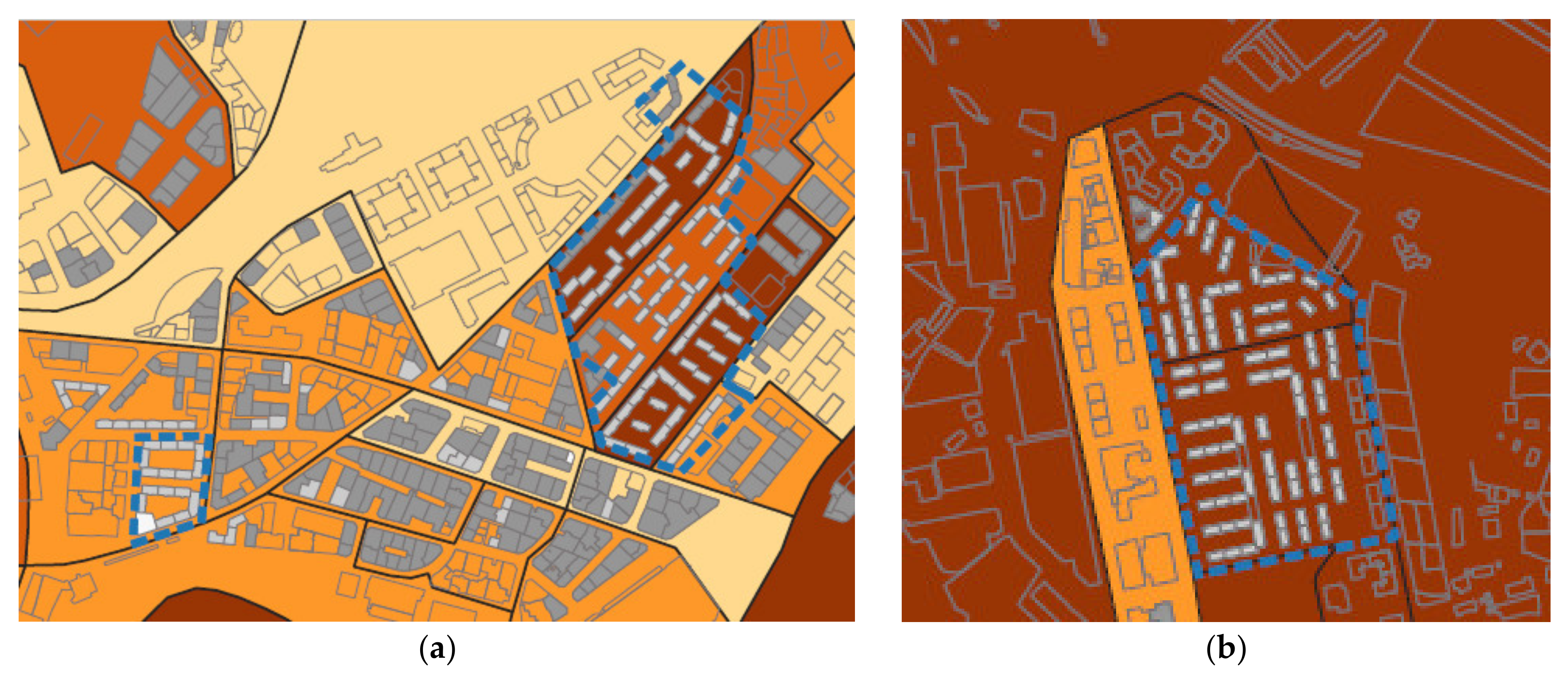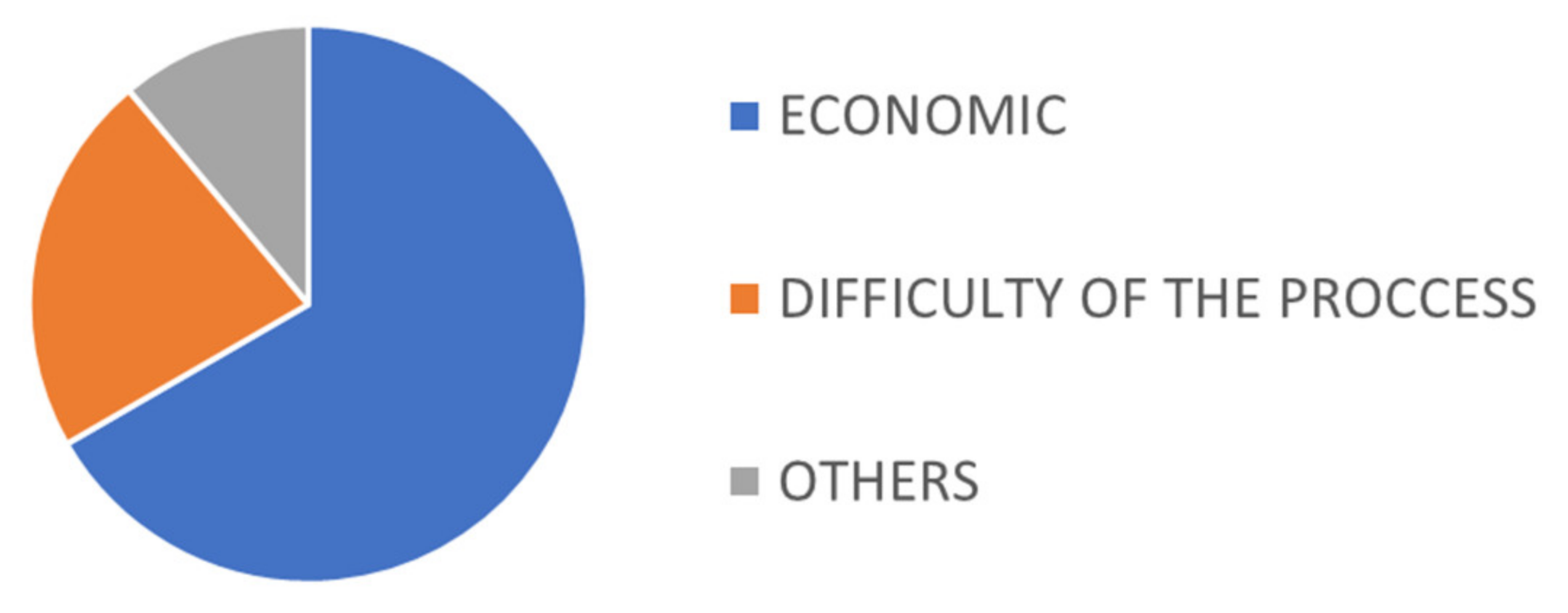Demand Aggregation as a Strategy for Untapping Buildings’ Energy Renovation Potential: Diagnosis and Prioritization Methodology and Case Study from the Basque Country
Abstract
1. Introduction
1.1. The Challenge
1.2. The Case of the Basque Country and the AGREE Project Approach
1.3. Objective and Structure
2. Methodology
2.1. Stage 1: Definition of the Universe of Analysis
2.2. Stage 2: Prioritization and Selection Based on Indicators
2.2.1. Building Indicators
- Accessibility of the building
- Conservation state of the building
- Energy efficiency of the building envelope
- Energy efficiency of the facilities
2.2.2. Socio-Economic Indicators
- Aging
- Family income
- Group 1: People with incomes between 9000 EUR/year and 13,000 EUR/year. From the maximum monthly amounts of the RGI for 2018, an average annual income of 12,000 EUR was established in this concept. On the other hand, funds in the form of non-refundable grants in these sections for works to improve energy efficiency (Type 2) and works to improve accessibility (Type 3) vary between 35% and 25% of the protectable budget up to a maximum of 5000 EUR for Type 2 and 5500 EUR for Type 3 works.
- Group 2: People with incomes from 13,001 EUR/year to 25,000 EUR/year. People in this annual income threshold do not receive financial benefits due to a lack of sufficient income, but they are eligible to receive non-refundable grants for works to improve energy efficiency (Type 2) and works to improve accessibility (Type 3) between 30% and 25% of the protectable budget up to a maximum of 5000 EUR for Type 2 works and 5500 EUR for Type 3 works. On the other hand, it is considered that these people can access qualified financing, the amount of which may reach the protectable budget, deducting non-refundable subsidies, where appropriate, up to a maximum of 18,000 EUR per home.
- Group 3: People with incomes between 25,000 EUR/year and 39,000 EUR/year. People with incomes greater than 25,000 EUR/year cannot be beneficiaries of individual aid, but they can obtain qualified financing as long as their annual income does not exceed 39,000 EUR.
- Group 4: People with incomes greater than 39,000 EUR/year are not eligible to benefit from qualified financing and therefore will have to request financing in the free market if they need it.
2.2.3. Opportunity Factor
2.3. Stage 3: Detailed Diagnosis of Selected Areas
2.3.1. Indicators for the Selected Area
2.3.2. Renovation Interest
3. Results
3.1. Prioritization of Renovation Areas (Stages 1 and 2)
3.2. Detailed Analysis of the Selected Area (Stage 3)
3.2.1. Population Indicators
3.2.2. Accessibility Indicators
3.2.3. Building Indicators
3.2.4. Dwelling Indicators
3.2.5. Renovation Interest
- interest in carrying out a home renovation;
- information about previous renovation works in the building;
- the priority of renovation actions: accessibility (lift installation), energy improvement (envelope renovation), aesthetic improvement (facade arrangement), or any kind of intervention derived from the compulsory Technical Building Inspection (ITE); and
- the main difficulty encountered in renovating their home (building): the economic aspect (a lack of financial resources), the difficulty of the process (too complicated), a lack of agreement among neighbours, etc.
- 56% of the residents stated that they had not carried out any type of construction work (Figure 17);
- 67% of the residents stated that their priority for renovation works is focused on accessibility (Figure 18); and
- the economic aspect (67%) and the difficulty of the renovation process itself (22%) were identified as the main barriers to home renovation (Figure 19).
4. Discussion and Conclusions
4.1. Barriers and Opportunities Found in the Application of the Methodology
4.2. Conclusions
Author Contributions
Funding
Institutional Review Board Statement
Informed Consent Statement
Data Availability Statement
Acknowledgments
Conflicts of Interest
References
- European Commission. Energy Efficient Buildings. Available online: https://ec.europa.eu/energy/en/topics/energy-efficiency/buildings (accessed on 13 December 2021).
- BPIE. Future-Proof Buildings for all Europeans—A Guide to Implement the Energy Performance of Buildings Directive. 2019. Available online: http://bpie.eu/publication/a-guide-to-implementing-the-energy-performance-of-buildings-directive/ (accessed on 13 December 2021).
- Ulterino, M.; Bloom, E. Energy Efficient Buildings: Europe. Energy Efficient HVAC, Lighting, Insulation and Glazing, Building Controls, and Energy Service Companies: Market Analysis and Forecasts; Navigant Research: Chicago, IL, USA, 2014. [Google Scholar]
- European Commission. Fostering Public Capacity to Plan, Finance and Manage Integrated Urban REGeneration for Sustainable Energy Uptake. FosterREG Project. Available online: https://cordis.europa.eu/project/id/649846 (accessed on 13 December 2021).
- European Commission. A Renovation Wave for Europe—Greening Our Buildings, Creating Jobs, Improving Lives; COM(2020) 662; European Commission: Brussels, Belgium, 2020. [Google Scholar]
- BPIE. Long-Term Renovation Strategies and Local Building Renovation Initiatives: Case Studies from 8 Countries. 2020. Available online: http://bpie.eu/publication/long-term-renovation-strategies-and-local-building-renovation-initiatives-case-studies-from-8-countries/ (accessed on 13 December 2021).
- Energy Efficiency Financial Institutions Group (2015): Energy Efficiency—The First Fuel for the EU Economy. How to Drive New Finance for Energy Efficiency Investments. Available online: http://www.eefig.com/index.php/the-eefig-report (accessed on 13 December 2021).
- van Kempen, R.; Dekker, K.; Hall, S.; Tosics, I. (Eds.) Restructing Large Housing Estates in Europe; The Policy Press, University of Bristol: Bristol, UK, 2005; Chapter 1; pp. 1–17. [Google Scholar]
- Conci, M.; Schneider, J. A district approach to building renovation for the integral energy redevelopment of existing residential areas. Sustainability 2017, 9, 747. [Google Scholar] [CrossRef]
- Terés-Zubiaga, J.; Bolliger, R.; Almeida, M.G.; Barbosa, R.; Rose, J.; Thomsen, K.E.; Montero, E.; Briones-Llorente, R. Cost-effective building renovation at district level combining energy efficiency & renewables—Methodology assessment proposed in IEA-Annex 75 and a demonstration case study. Energy Build. 2020, 224, 110280. [Google Scholar] [CrossRef]
- Häkkinen, T.; Ala-Juusela, M.; Mäkeläinen, T.; Jung, N. Drivers and benefits for district-scale energy refurbishment. Cities 2019, 94, 80–95. [Google Scholar] [CrossRef]
- Rose, J.; Thomsen, K.E.; Domingo-Irigoyen, S.; Bolliger, R.; Venus, D.; Konstantinou, T.; Mlecnik, E.; Almeida, M.; Barbosa, R.; Terés-Zubiaga, J.; et al. Building renovation at district level—Lessons learned from international case studies. Sustain. Cities Soc. 2021, 72, 103037. [Google Scholar] [CrossRef]
- Ibarloza, A.; Malles, E.; Ibarloza, E.; Heras-Saizarbitoria, I. The needs and effects of housing renewal policies in Spain: Implications for sustainability and accessibility. Sustain. Cities Soc. 2018, 40, 244–253. [Google Scholar] [CrossRef]
- Häkkinen, T.; Rekola, M.; Ala-Juusela, M.; Ruuska, A. Role of Municipal Steering in Sustainable Building and Refurbishment. Energy Procedia 2016, 96, 650–661. [Google Scholar] [CrossRef]
- Paiho, S.; Ketomäki, J.; Kannari, L.; Häkkinen, T.; Shemeikka, J. A new procedure for assessing the energy-efficient refurbishment of buildings on district scale. Sustain. Cities Soc. 2019, 46, 101454. [Google Scholar] [CrossRef]
- Martín-Consuegra, F.; de Frutos, F.; Oteiza, I.; Agustín, H.A. Use of cadastral data to assess urban scale building energy loss. Application to a deprived quarter in Madrid. Energy Build. 2018, 171, 50–63. [Google Scholar] [CrossRef]
- D’Alonzo, V.; Novelli, A.; Vaccaro, R.; Vettorato, D.; Albatici, R.; Diamantini, C.; Zambelli, P. A bottom-up spatially explicit methodology to estimate the space heating demand of the building stock at regional scale. Energy Build. 2020, 206, 109581. [Google Scholar] [CrossRef]
- Santamouris, M.; Kapsis, K.; Korres, D.; Livada, I.; Pavlou, C.; Assimakopoulos, M.N. On the relation between the energy and social characteristics of the residential sector. Energy Build. 2007, 39, 893–905. [Google Scholar] [CrossRef]
- de Cos Guerra, O.; Usobiaga Ferrer, E. Methodological challenges to study demographic and residential deprivation on an intra-urbano level to face changes on common statistical sources | Retos metodológicos para estudiar la vulnerabilidad demográfica y residencial a nivel intraurbano ante los cambios en las Fuentes estadísticas habituales. Scripta Nova 2019, 23. [Google Scholar] [CrossRef]
- OECD. Integrating Distressed Urban Areas; OECD Publishing: Paris, France, 1998. [Google Scholar] [CrossRef]
- Ministerio de Transportes, Movilidad y Agenda Urbana. Observatorio de la Vulnerabilidad Urbana. 2021. Available online: https://www.mitma.gob.es/arquitectura-vivienda-y-suelo/urbanismo-y-politica-de-suelo/observatorio-de-la-vulnerabilidad-urbana (accessed on 13 December 2021).
- Rodríguez Suárez, I.; Hernández Aja, A.; Gómez Giménez, J.M.; Matesanz Parellada, Á.; Díez Bermejo, A. Los Catálogos de Barrios Vulnerables de España. Análisis de la vulnerabilidad en las ciudades españolas entre 1991 y 2011. Ciudad y Territorio Estudios Territoriales 2021, vol. LIII (2021 MONO), 179–200. [Google Scholar] [CrossRef]
- Ministerio de Transportes, Movilidad y Agenda Urbana. Atlas de la Edificación Residencial en España 2001–2011. 2021. Available online: http://atlasedificacion.fomento.es/#c=home (accessed on 13 December 2021).
- De Santiago-Rodríguez, E. La Estrategia de Rehabilitación ERESEE 2020: Una oportunidad para un cambio de modelo en el sector de la vivienda en España. Ciudad y Territorio Estudios Territoriales 2021, 53 (2021 MONO), 239–276. [Google Scholar] [CrossRef]
- Molina-Costa, P. Las Estrategias Locales de Regeneración y Rehabilitación y su potencial para el impulso de las actuaciones de rehabilitación con criterios de eficiencia energética. In Innovaciones Recientes en España en Materia de Rehabilitación y Regeneración Urbana; Estudio (08) para la ERESEE 2020 “Estrategia a largo plazo para la Rehabilitación Energética en el Sector de la Edificación en España”; Ministerio de Fomento: Madrid, Spain, 2019; pp. 47–62. Available online: https://cdn.mitma.gob.es/portal-web-drupal/planes_estartegicos/8_2020_innovaciones_sobre_rehabilitacion_anexo_i.pdf (accessed on 13 December 2021).
- Fundación Tecnalia Research & Innovation, GIAU+S-UPM and caviar-UPV. Diagnóstico de las Necesidades de Intervención en la Renovación del Parque Edificado de la CAPV. Departamento de Vivienda, Obras Públicas y Transportes, Gobierno Vasco, 2011. Available online: https://www.etxebide.euskadi.eus/x39-ovad03/es/contenidos/informacion/ovv_direcc_vivienda/es_ovv_sevi/ovv_sectorvivienda245_es.html (accessed on 13 December 2021).
- Consejería de Fomento y Medio Ambiente, Junta de Castilla y León. Estrategia de Regeneración Urbana en Castilla y León (ERUrCyL). 2016. Available online: http://www.jcyl.es/junta/cma/ERUCyL.pdf (accessed on 13 December 2021).
- Serrano Lanzarote, B.; García Prieto Ruiz, A.; de los Ríos Rúperez, I.; Soto Francés, L.; Temes Cordovez, R.; Gil Vila, M.; Azara Escrivá, S.; Hervás Más, J.; Rodriguez Contreras, C.; de Leon, Y. Directrices Para el Desarrollo de Estrategias de Regeneración Urbana Para Municipios de la Comunitat Valenciana. Instituto Valenciano de la Edificación, 2018. Available online: http://www.habitatge.gva.es/es/web/vivienda-y-calidad-en-la-edificacion/estrategia-de-regeneracion-urbana-de-la-comunitat-valenciana (accessed on 13 December 2021).
- Ruiz Palomeque, G.; Rubio del Val, J. Estudios y Propuestas para la Rehabilitación de 21 Conjuntos Urbanos de Interés. Zaragoza Vivienda, 2006. Available online: http://oa.upm.es/14586/2/Nuevas_Propuestas_de_Rehabilitacion_Urbana_de_Zaragoza_3.pdf (accessed on 13 December 2021).
- Foment de Ciutat, S.A. Estudi i Detecció a la Ciutat de Barcelona d’àmbits de Vulnerabilitat Residencial. 2017. Available online: https://bcnroc.ajuntament.barcelona.cat/jspui/handle/11703/102699 (accessed on 13 December 2021).
- Villacañas Beades, S.; Vila, G.; Moix, M.; Vima, S.; Balcells, A.; Amela, J. MADRID RECUPERA Estrategia de Regeneración Urbana. Dirección General de Planificación Estratégica, Área de Gobierno de Desarrollo Urbano Sostenible, Ayuntamiento de Madrid, 2016. Available online: https://planmadre.madrid.es/ (accessed on 13 December 2021).
- Andrés Mateo, C.; Masiá González, L. Plan Especial de Reforma Interior Para la Planificación de Actuaciones de Rehabilitación, Regeneración y Renovación Urbana, en el Municipio de Palencia. Avance; Ayuntamiento de Palencia: Palencia, Spain, 2018. [Google Scholar]
- Molina-Costa, P. Methodology for Demarcation of Priority Areas for Integrated Urban Regeneration. In Proceedings of the BIA Urban Regeneration Forum 2014, Bilbao, Spain, 24–26 September 2014. [Google Scholar]
- Fundación Tecnalia Research & Innovation; Ekoiure Abogados; MaaB Arquitecura y Urbanismo; Fincas Ezkurdi. Ecoinnovación en Regeneración Urbana: Guía Metodológica Para la Regeneración Urbana Integrada de los Barrios de la CAPV Construidos en 1950–1970; Ihobe: Bilbao, Spain, 2018. [Google Scholar]
- Rubio del Val, J.; Molina Costa, P. Estrategias, retos y oportunidades en la rehabilitación de los polígonos de vivienda construidos en España entre 1940 y 1980. Ciudades 2017, 13, 15–37. [Google Scholar] [CrossRef][Green Version]



















| Index | Indicator | Weight |
|---|---|---|
| Need index according to the state of the building | % of buildings without a lift | 2 |
| % of buildings in very poor condition | 1 | |
| % of buildings built between 1940 and 1959 | 0.5 | |
| % of homes without gas by pipeline | 0.25 | |
| % of homes with inefficient heating | 0.25 | |
| Priority index according to the socioeconomic profile | % of population older than 64 years | 2 |
| Average family income in the range 13,000–25,000 EUR | 2 | |
| Combined prioritization index | Need index according to the state of the building | 4 |
| Priority index according to the socioeconomic profile | 4 |
| Name of Field_AGREE | Description | Source | Year | Frequency Update |
|---|---|---|---|---|
| VIVTOT | Total number of dwellings by postal address | Real state Cadastre | 2019 | Annual |
| POBTOT | Total population by postal address | Municipal Register of Inhabitants | 2019 | Annual |
| N_HOMBR | Number of men by postal address | Municipal Register of Inhabitants | 2019 | Annual |
| N_MUJER | Number of women by postal address | Municipal Register of Inhabitants | 2019 | Annual |
| N_MA65 | Population over 65 years of age by postal address | Municipal Register of Inhabitants | 2019 | Annual |
| N_MA79 | Population older than 79 years by postal address | Municipal Register of Inhabitants | 2019 | Annual |
| N_ME15 | Population under 15 years of age by postal address | Municipal Register of Inhabitants | 2019 | Annual |
| POBNAC | Population of national origin by postal address | Municipal Register of Inhabitants | 2019 | Annual |
| POBEXTR | Population of foreign origin by postal address | Municipal Register of Inhabitants | 2019 | Annual |
| pP_MA65 | Percentage of portal population over 65 years old, by postal address | Municipal Register of Inhabitants | 2019 | Annual |
| pP_MA79 | Percentage of portal population over 79 years old, by postal address | Municipal Register of Inhabitants | 2019 | Annual |
| ASCENSOR | The building has a lift, by postal address | Department of Industry of the Basque Government | 2019 | Annual |
| ENV_ASC | Buildings with an aging population and no lift, by postal address | Cross between the Municipal Register of Inhabitants/cadastre | 2019 | Annual |
| VIV_ALQ | Number of homes for rent, by postal address | Basque Housing Observatory based on the data from the Register of Bonds and Contracts | 2019 | Annual |
| pV_ALQ | Percentage of portal housing for rent, by postal address | Basque Housing Observatory based on the data from the Register of Bonds and Contracts | 2019 | Annual |
| VIV_VAC | Number of empty houses, by postal address | Cross between the Municipal Register of Inhabitants/cadastre | 2019 | Annual |
| pV_VAC | Percentage of empty portal houses, by postal address | Cross between the Municipal Register of Inhabitants/cadastre | 2019 | Annual |
| VIV_AYUD | Number of homes that have received social assistance, by postal address | Cross between the Municipal Register of Inhabitants/social services | 2019 | Annual |
| p_V_AYUD | Percentage of homes on the portal that receive social assistance, by postal address | Cross between the Municipal Register of Inhabitants/cadastre | 2019 | Annual |
| ITE | A Technical Building Inspection (ITE) has been performed, by postal address | Basque Housing Observatory based on data from EuskoRegite (the Basque Country Government’s platform for the registration of Buildings of the Basque Country that have undergone a Technical Inspection) except for Vitoria-Gasteiz * | 2019 | Annual |
| ITE_EE | Global EE Indicator, by postal address | Basque Housing Observatory based on data from EuskoRegite | 2019 | Annual |
| OBRAFACH | Works on the facade have been carried out in the last 10 years, by postal address | Municipal urban planning department based on building construction works licenses | 2020 | Annual |
| OBRACUB | Roof works have been carried out in the last 10 years, by postal address | Municipal urban planning department based on building construction works licenses | 2020 | Annual |
| Data | Number | % |
|---|---|---|
| Buildings (postal address) | 99 | |
| Number of Dwellings | 985 | |
| Total population | 2028 | |
| People > 65 years | 408 | 20% of the total population |
| People > 79 years | 231 | 57% of pop. > 65 years |
| Dwellings with social welfare | 182 | 18% |
Publisher’s Note: MDPI stays neutral with regard to jurisdictional claims in published maps and institutional affiliations. |
© 2021 by the authors. Licensee MDPI, Basel, Switzerland. This article is an open access article distributed under the terms and conditions of the Creative Commons Attribution (CC BY) license (https://creativecommons.org/licenses/by/4.0/).
Share and Cite
Nicolas, O.; Molina-Costa, P. Demand Aggregation as a Strategy for Untapping Buildings’ Energy Renovation Potential: Diagnosis and Prioritization Methodology and Case Study from the Basque Country. Sustainability 2021, 13, 13881. https://doi.org/10.3390/su132413881
Nicolas O, Molina-Costa P. Demand Aggregation as a Strategy for Untapping Buildings’ Energy Renovation Potential: Diagnosis and Prioritization Methodology and Case Study from the Basque Country. Sustainability. 2021; 13(24):13881. https://doi.org/10.3390/su132413881
Chicago/Turabian StyleNicolas, Olatz, and Patricia Molina-Costa. 2021. "Demand Aggregation as a Strategy for Untapping Buildings’ Energy Renovation Potential: Diagnosis and Prioritization Methodology and Case Study from the Basque Country" Sustainability 13, no. 24: 13881. https://doi.org/10.3390/su132413881
APA StyleNicolas, O., & Molina-Costa, P. (2021). Demand Aggregation as a Strategy for Untapping Buildings’ Energy Renovation Potential: Diagnosis and Prioritization Methodology and Case Study from the Basque Country. Sustainability, 13(24), 13881. https://doi.org/10.3390/su132413881






